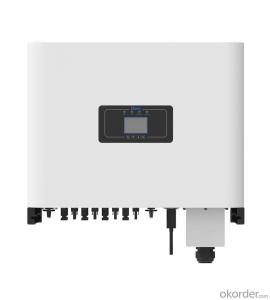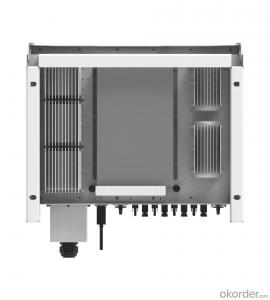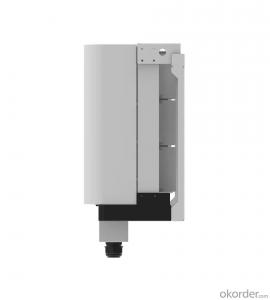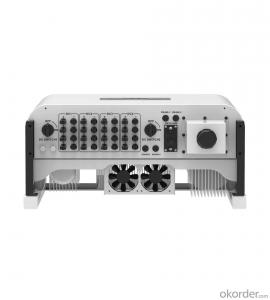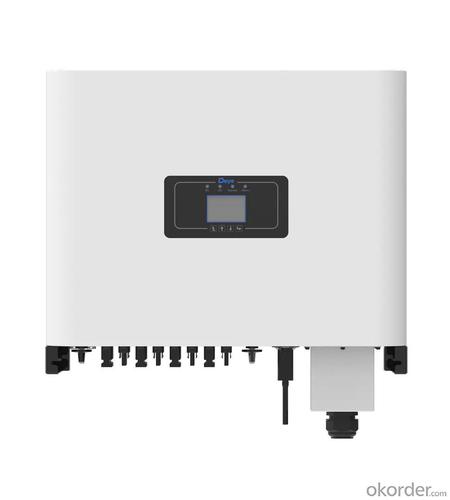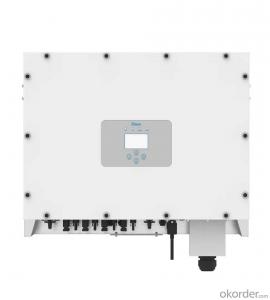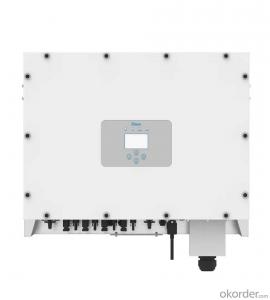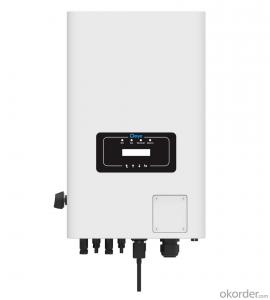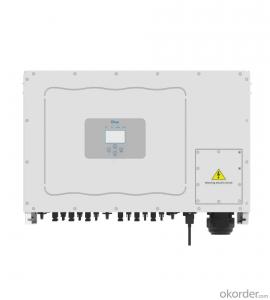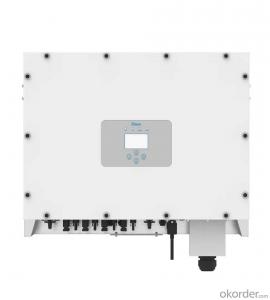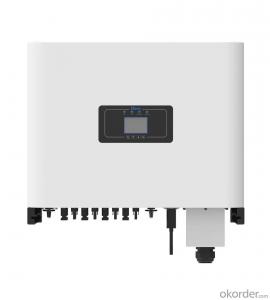Danfoss Solar Inverter - sun-30/33/35/40/50/60k-g03 | 30-60kw | Three Phase | 4 MPPT
- Loading Port:
- Ningbo
- Payment Terms:
- TT OR LC
- Min Order Qty:
- 1000 pc
- Supply Capability:
- 5000 pc/month
OKorder Service Pledge
OKorder Financial Service
You Might Also Like
Specification
| Technical Data | ||||||||
| Model | SUN-30K-G03 | SUN-33K-G03 | SUN-35K-G03 | SUN-40K-G03 | SUN-50K-G03 | SUN-60K-G03 | ||
| Input Side | ||||||||
| Max. DC Input Power (kW) | 39 | 42.9 | 45.5 | 52 | 65 | 78 | ||
| Max. DC Input Voltage (V) | 1000 | |||||||
| Start-up DC Input Voltage (V) | 250 | |||||||
| MPPT Operating Range (V) | 200~850 | |||||||
| Max. DC Input Current (A) | 40+40 | 40+40+40 | 40+40+40+40 | |||||
| Max. Short Circuit Current (A) | 60+60 | 60+60+60 | 60+60+60+60 | |||||
| Number of MPPT / Strings per MPPT | 2/3 | 3/3 | 4/3 | |||||
| Output Side | ||||||||
| Rated Output Power (kW) | 30 | 33 | 35 | 40 | 50 | 60 | ||
| Max. Active Power (kW) | 33 | 36.3 | 38.5 | 44 | 55 | 66 | ||
| Nominal Output Voltage / Range (V) | 3L/N/PE 380V/0.85Un-1.1Un, 400V/0.85Un-1.1Un | |||||||
| Rated Grid Frequency (Hz) | 50 / 60 (Optional) | |||||||
| Operating Phase | Three phase | |||||||
| Rated AC Grid Output Current (A) | 43.5 | 47.8 | 50.7 | 58 | 72.5 | 87 | ||
| Max. AC Output Current (A) | 47.9 | 52.6 | 55.8 | 63.8 | 79.7 | 95.7 | ||
| Output Power Factor | 0.8 leading to 0.8 lagging | |||||||
| Grid Current THD | <3% | |||||||
| DC Injection Current (mA) | <0.5% | |||||||
| Grid Frequency Range | 47~52 or 57~62 (Optional) | |||||||
| Efficiency | ||||||||
| Max. Efficiency | 98.7% | |||||||
| Euro Efficiency | 98% | |||||||
| MPPT Efficiency | >99% | |||||||
| Protection | ||||||||
| DC Reverse-Polarity Protection | Yes | |||||||
| AC Short Circuit Protection | Yes | |||||||
| AC Output Overcurrent Protection | Yes | |||||||
| Output Overvoltage Protection | Yes | |||||||
| Insulation Resistance Protection | Yes | |||||||
| Ground Fault Monitoring | Yes | |||||||
| Anti-islanding Protection | Yes | |||||||
| Temperature Protection | Yes | |||||||
| Integrated DC Switch | Yes | |||||||
| Remote software upload | Yes | |||||||
| Remote change of operating parameters | Yes | |||||||
| Surge protection | DC Type II / AC Type II | |||||||
| General Data | ||||||||
| Size (mm) | 647.5W×537H×303.5D | |||||||
| Weight (kg) | 44.5 | |||||||
| Topology | Transformerless | |||||||
| Internal Consumption | <1W (Night) | |||||||
| Running Temperature | -25~65℃, >45℃ derating | |||||||
| Ingress Protection | IP65 | |||||||
| Noise Emission (Typical) | <45 dB | |||||||
| Cooling Concept | Smart cooling | |||||||
| Max. Operating Altitude Without Derating | 2000m | |||||||
| Warranty | 5 years | |||||||
| Grid Connection Standard | CEI 0-21, VDE-AR-N 4105, NRS 097, IEC 62116, IEC 61727, G99, G98, VDE 0126-1-1, RD 1699, C10-11 | |||||||
| Operating Surroundings Humidity | 0-100% | |||||||
| Safety EMC / Standard | IEC/EN 61000-6-1/2/3/4, IEC/EN 62109-1, IEC/EN 62109-2 | |||||||
| Features | ||||||||
| DC Connection | MC-4 mateable | |||||||
| AC Connection | IP65 rated plug | |||||||
| Display | LCD 240×160 | |||||||
| Interface | RS485/RS232/Wifi/LAN | |||||||
This series grid-tie inverter is preferred choice for commercial PV system. With the free-standing design, it greatly reduces installation time and costs. With a Max. 4 MPPTs design and Max. capacity of 50 kW, it is scalable up to the megawatt range.
· 4 MPP tracker, Max. efficiency up to 98.7%
· Zero export application, VSG application
· String intelligent monitoring (optional)
· Wide output voltage range
· Type II DC/AC SPD
· Anti-PID function (Optional)
- Q: What is the typical lifespan of the capacitors in a solar inverter?
- The typical lifespan of capacitors in a solar inverter can vary depending on various factors such as the quality of the components used, the operating conditions, and the amount of stress placed on the capacitors. However, on average, the lifespan of capacitors in a solar inverter can be expected to be around 10 to 15 years. Capacitors are electronic components that store and release electrical energy, and they play a crucial role in the functioning of a solar inverter. They help regulate voltage, smooth out fluctuations in power, and provide stability to the electrical system. The lifespan of capacitors in a solar inverter is influenced by several factors. One of the most significant factors is the quality of the capacitors themselves. Higher quality capacitors tend to have better performance and durability, resulting in a longer lifespan. Cheaper or lower-quality capacitors may degrade or fail more quickly. Another factor that affects the lifespan of capacitors is the operating conditions. Solar inverters are typically installed outdoors, exposed to temperature variations, moisture, and other environmental factors. Extreme temperatures, excessive humidity, or exposure to direct sunlight can potentially accelerate the deterioration of capacitors and reduce their lifespan. Additionally, the stress placed on the capacitors can impact their lifespan. This stress can be caused by factors such as voltage fluctuations, high-frequency switching, or overloading of the inverter. If a solar inverter is operated beyond its design limits or experiences frequent power fluctuations, it can put additional strain on the capacitors, potentially leading to premature failure. Regular maintenance and monitoring of the solar inverter can help identify any potential issues with the capacitors and address them promptly. Some manufacturers may offer warranties or provide information on the expected lifespan of their capacitors, which can give an indication of their durability. In summary, the typical lifespan of capacitors in a solar inverter is around 10 to 15 years, but this can vary depending on factors such as component quality, operating conditions, and stress placed on the capacitors. Regular maintenance and monitoring can help ensure the longevity and optimal performance of the capacitors in a solar inverter system.
- Q: How does a solar inverter handle grid synchronization during startup?
- During startup, a solar inverter handles grid synchronization by first ensuring that the grid is stable and within acceptable voltage and frequency ranges. It then synchronizes its output voltage and frequency with the grid by monitoring its phase angle and adjusting it accordingly. This synchronization process allows the solar inverter to safely and seamlessly connect to the grid, ensuring smooth power transfer and operation.
- Q: How do you choose the right size solar inverter for a specific solar power system?
- Choosing the right size solar inverter for a specific solar power system requires careful consideration of various factors. Here are some steps to help you make the right choice: 1. Determine your solar power system's capacity: Start by calculating the total capacity of your solar power system. This involves determining the total wattage of all your solar panels combined. This information can usually be found on the product specifications or by consulting with your solar panel manufacturer. 2. Consider your average energy consumption: Assess your average energy consumption to determine the size of the solar inverter needed to meet your requirements. Consider your peak power usage and any potential future increase in energy demands. 3. Evaluate the inverter's capacity: Match the capacity of the solar inverter with your solar power system's capacity. The inverter's capacity should be equal to or slightly higher than your system's total capacity to ensure optimal performance. 4. Consider the inverter's efficiency: Look for an inverter with high efficiency ratings. A higher efficiency rating means that it can convert a larger percentage of the solar energy into usable electricity, minimizing power losses. 5. Determine the inverter type: Decide on the type of solar inverter suitable for your system. There are three main types: string inverters, microinverters, and power optimizers. String inverters are the most common and cost-effective option for small to medium-sized systems, while microinverters and power optimizers are better suited for complex installations or systems with shading issues. 6. Assess the inverter's features: Consider additional features that the solar inverter may offer. Look for features such as monitoring capabilities, grid integration capabilities, and built-in safety features like arc fault protection or rapid shutdown. 7. Consult with professionals: If you are uncertain about the right size solar inverter for your specific solar power system, it is advisable to consult with a professional solar installer or an electrical engineer. They can help assess your energy needs, system requirements, and provide expert guidance on selecting the appropriate inverter size. Remember, choosing the right size solar inverter is crucial for the overall performance and efficiency of your solar power system. Taking the time to evaluate your system's requirements and seeking expert advice will help ensure you make an informed decision.
- Q: Can a solar inverter be used with a generator as a backup power source?
- Yes, a solar inverter can be used with a generator as a backup power source. The solar inverter can be connected to the generator's output, allowing it to convert the generator's AC power into usable DC power for charging the batteries or powering the solar energy system. This setup ensures uninterrupted power supply during periods of low solar generation or in case of power outages.
- Q: Can a solar inverter be used with a solar-powered outdoor lighting system?
- Yes, a solar inverter can be used with a solar-powered outdoor lighting system. A solar inverter is responsible for converting the direct current (DC) generated by solar panels into alternating current (AC) that can be used to power electrical devices. In the case of a solar-powered outdoor lighting system, the solar inverter can be used to convert the DC power generated by the solar panels into AC power that can be used to light up the outdoor lights during nighttime.
- Q: Can a solar inverter be used for three-phase power systems?
- Yes, a solar inverter can be used for three-phase power systems. Three-phase solar inverters are specifically designed to convert the DC power generated by solar panels into AC power for three-phase electrical systems. These inverters are capable of handling the higher voltage and power requirements of three-phase systems, making them suitable for commercial and industrial installations.
- Q: Can a solar inverter be used in a commercial or industrial setting?
- Yes, a solar inverter can be used in a commercial or industrial setting. In fact, they are commonly used in these settings to convert the direct current (DC) electricity generated by solar panels into alternating current (AC) electricity that is suitable for use in commercial or industrial buildings. Solar inverters are designed to handle larger electricity loads and are capable of efficiently powering various electrical equipment and machinery in such settings.
- Q: How does a solar inverter handle voltage fluctuations during grid disturbances?
- A solar inverter handles voltage fluctuations during grid disturbances by continuously monitoring the grid voltage. When it detects a fluctuation or disturbance, it adjusts its own output voltage to match the grid's voltage. This ensures that the solar inverter remains synchronized with the grid and delivers stable electricity without causing any damage to the connected appliances or the grid itself.
- Q: What safety features should a solar inverter have?
- A solar inverter should have several safety features, including overvoltage protection, overcurrent protection, ground fault protection, and arc fault protection. Additionally, it should have robust insulation to prevent electrical shock hazards and be equipped with sensors to monitor temperature and prevent overheating. Finally, it should have a secure enclosure to protect against environmental factors such as water, dust, and debris.
- Q: Are there any government incentives available for solar inverters?
- Yes, there are government incentives available for solar inverters in many countries. These incentives are aimed at promoting the adoption of renewable energy and reducing carbon emissions. One common incentive is the solar investment tax credit (ITC) in the United States, which allows homeowners and businesses to deduct a percentage of their solar installation costs from their federal taxes. In some countries, such as Germany, there are feed-in tariffs that require utility companies to pay a premium for the electricity generated by solar inverters. Additionally, some local governments offer grants or rebates for installing solar inverters or offer low-interest loans to finance the purchase and installation of the equipment. It is important to check with your local government or relevant authorities to understand the specific incentives available in your region.
Send your message to us
Danfoss Solar Inverter - sun-30/33/35/40/50/60k-g03 | 30-60kw | Three Phase | 4 MPPT
- Loading Port:
- Ningbo
- Payment Terms:
- TT OR LC
- Min Order Qty:
- 1000 pc
- Supply Capability:
- 5000 pc/month
OKorder Service Pledge
OKorder Financial Service
Similar products
Hot products
Hot Searches
Related keywords
